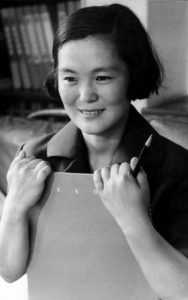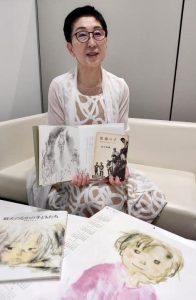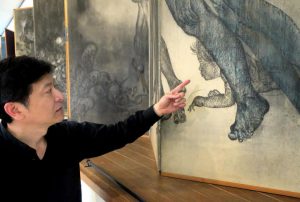An anti-nuclear life, Part 8: Chihiro Iwasaki (painter, picture book author, 1918–1974)
Sep. 28, 2024
Expressing her feelings in images of children
Power of accusation imbued in their charm
by Masakazu Domen, Senior Staff Writer
When it comes to depicting the expressions of happiness on the face of a child, such as a baby wrapped in a fluffy towel by its mother after a bath, no one rivals Chihiro Iwasaki.
Even now, 50 years after Ms. Iwasaki’s death, her following continues to grow through the many reprints of collections of her artwork and illustrated picture books, drawn with soft lines and pale colors like a whisper of life. The charm overflowing from the children in her paintings is a universal beauty that resonates with people the world over.
Ms. Iwasaki died of illness at the age of 55. In her later years, she produced three picture books about war in which children are the main characters — Watashi ga Chiisakatta Toki ni (in English, ‘When I Was a Child’), published in 1967; Kaasan wa Orusu (‘Mother is not at Home’), in 1972; and Senka no Naka no Kodomotachi (‘Children in the Flames of War’), 1973. Watashi ga Chiisakatta Toki ni is a picture book adaptation of Children of the Atomic Bomb, a collection of experiences in the atomic bombing of Hiroshima children compiled and edited by the educator Arata Osada.
In May 1967, Chihiro visited Hiroshima from Tokyo for the first time with an editor from her publisher to collect information for Watashi ga Chiisakatta Toki ni, carrying a sketchbook and the camera she often used. Yuko Yamaguchi, author of the picture book Okorijizo (‘The Angry Jizo’), served as their guide in Hiroshima.
Yuko Takesako, 68, a Hiroshima native who worked as a curator at the Chihiro Art Museum Tokyo and as deputy director of the Chihiro Art Museum Azumino, in Nagano Prefecture, has studied Chihiro’s time spent in Hiroshima. According to Ms. Takesako, the visit was a three-day, two-night trip, during which Chihiro drew seven sketches and took four photographs. “That is a very small amount compared to her other trips for collecting information,” she said.
Chihiro made one sketch of the steel framework on the upper part of the A-bomb Dome in Peace Memorial Park, located in Hiroshima’s Naka Ward, but the other artwork she created on the trip was made up of such scenery as the mountains seen from downtown. As for the few photos, Chihiro took one of the Children’s Peace Monument in the park, and the only others were of the old main pillars of Aioi Bridge and two views of the city taken from a distance.
According to the recollections of people accompanying her, on the day of Chihiro’s arrival in Hiroshima she visited an acquaintance in the area of Kabe, located in the city’s Asakita Ward, and stayed at a hotel near the hypocenter. However, appearing unable to sleep, she remarked, “There are still children’s bones buried under the floor, aren’t there?”
The next day, speaking few words, she toured relics from the atomic bombing that remained in the city but firmly refused her scheduled visit to the Hiroshima Peace Memorial Museum. There seemed to be some awkwardness between Chihiro and Ms. Yamaguchi, her guide around the city. Chihiro changed her accommodations for the night to Miyajima, located in Hatsukaiichi City, and departed Hiroshima directly from there.
It might be assumed that her information gathering in Hiroshima for the book had ended on a bad note. However, Ms. Takesako gives high marks to the completed work as “an important book that marks a milestone in her creative career” and believes that “the experience of creating this book and its success laid the foundation for the styles and concepts she used in her next two books on the subject of the Vietnam War.”
No matter how sorrowful the scenes depicted in the stories, Chihiro illustrated the children as having irresistible charm. Some are shown as having eyes blank with sorrow, but there are no depictions of badly burned skin, for example. With that, her illustrations have the power of accusation, conveying just how precious is children’s happiness, robbed from them by the atomic bombing, by war, and by adults.
On a page in a personal account written by the older sister of an eight-year-old girl is the story of how her younger sister, with a “completely transformed appearance,” had walked back home to the village of Miiri, in Hiroshima’s present-day Asakita Ward, and died one month later. Chihiro illustrated the girl plodding along while surrounded by many wild flowers.
After the war, Chihiro determined to live her life as a painter and traveled to Tokyo from Nagano, where she had evacuated, in the spring of 1946. In Tokyo, where postwar reconstruction had just begun, she attended drawing classes put on by Iri and Toshi Maruki, the artist couple who later became known for their artwork titled “Hiroshima Panels.” Chihiro’s illustrations appearing in newspapers at the time clearly reveal Toshi’s influence on her work.
She continued her friendship with Mr. and Mrs. Maruki until the early 1960s, a period that coincided with the creation of 11 of the 15 “Hiroshima Panels.” Yukinori Okamura, a curator at the Maruki Gallery for the Hiroshima Panels, located in Higashimatsuyama City in Saitama Prefecture, said, “There is no doubt she heard numerous stories about the atomic bombing from the Marukis, who knew of the tragedy firsthand. There is even some brushwork in the ‘Hiroshima Panels’ that Chihiro might have had a hand in.”
Before illustrating Watashi ga Chiisakatta Toki ni, she is reported to have said, “Although I can’t paint like Mr. and Mrs. Maruki…,” but she openly expressed her enthusiasm and sense of mission. The anecdote about her trip to Hiroshima appears to show her sensitivity, or maybe it was proof of her confidence. Perhaps Chihiro’s idea of the A-bombed Hiroshima had already matured in her mind with the image of the children, who she was able to illustrate without the need to hastily gather information.
Chihiro Iwasaki
Born in Fukui Prefecture, Chihiro was raised in Tokyo. Iwasaki was Chihiro’s maiden name. She first married in her 20s and lived in the former Manchuria (in northeastern China). She returned to her parents’ home in Tokyo, which was later destroyed in an air raid. She experienced the end of the war at the home of her mother’s parents in Nagano Prefecture. After the war, she threw herself into her painting in Tokyo and remarried. She created numerous picture books of renown while raising her only son. The photographs are courtesy of the Chihiro Art Museum.
(Originally published on September 28, 2024)










